LG Electronics 002KPYR0001018 User Manual
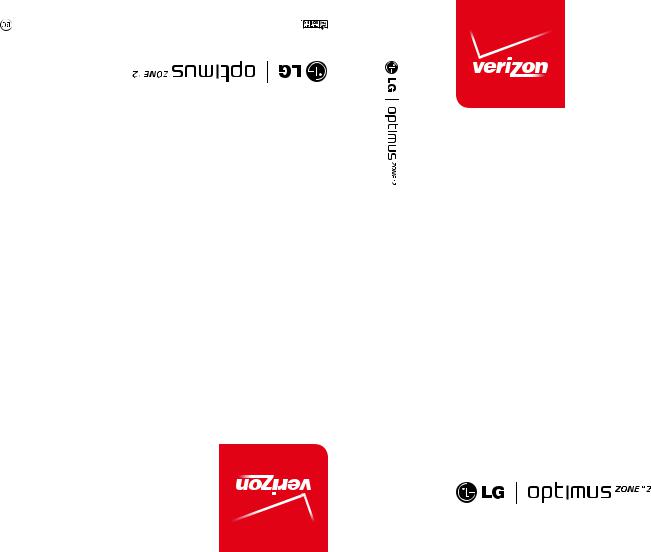
PrintedinMexico |
Thisbookletisprintedwithsoy.ink |

 Thisbookletismadefrom95%post-consumerrecycled.paper
Thisbookletismadefrom95%post-consumerrecycled.paper
Usuario Guíadel
User Guide
Guide User
MW 0).(1 MFL68321201
&RS\ULJKW /* (OHFWURQLFV ,QF $OO ULJKWV UHVHUYHG /* DQG WKH /* ORJR DUH UHJLVWHUHG WUDGHPDUNV RI /* &RUS $OO RWKHU WUDGHPDUNV DUH WKH SURSHUW\ RI WKHLU UHVSHFWLYH RZQHUV

Important Customer Information 1
Before you begin
Before reading this user guide and getting started, please review the separate Product Safety and Warranty Information guide for important product safety and warranty information about your device.

2Table of Contents
Important Customer Information........................................................... |
1 |
Table of Contents ................................................................................... |
2 |
The Basics............................................................................................... |
4 |
Phone overview..................................................................................................... |
4 |
Installing the battery............................................................................................. |
7 |
Charging the phone............................................................................................. |
8 |
The memory card................................................................................................ |
10 |
Locking and unlocking the screen...................................................................... |
11 |
Touchscreen tips.................................................................................................. |
15 |
Home screen........................................................................................................ |
16 |
Google Account Setup......................................................................... |
27 |
Creating your Google Account ......................................................................... |
27 |
Signing in to your Google Account .................................................................. |
27 |
Connecting to Networks and Devices ............................................... |
28 |
Wi-Fi.................................................................................................................... |
28 |
Bluetooth............................................................................................................. |
29 |
Connecting to Virtual Private Networks............................................................ |
31 |
PC connections with a USB Cable .................................................................... |
31 |
Calls ....................................................................................................... |
33 |
Making a call....................................................................................................... |
33 |
Calling your contacts ......................................................................................... |
33 |
Call settings........................................................................................................ |
36 |
Communication .................................................................................... |
37 |
Contacts.............................................................................................................. |
37 |
Messaging............................................................................................................ |
41 |
Email.................................................................................................................... |
43 |
Entertainment...................................................................................... |
46 |
Camera................................................................................................................ |
46 |
Video Camera..................................................................................................... |
50 |
Gallery ................................................................................................................. |
53 |
Videos.................................................................................................................. |
56 |
Music ................................................................................................................... |
57 |
QuickMemo ........................................................................................................ |
59 |

Table of Contents 3
Tools....................................................................................................... |
59 |
Alarm/Clock......................................................................................................... |
61 |
Calculator............................................................................................................ |
62 |
Calendar.............................................................................................................. |
62 |
Tasks.................................................................................................................... |
63 |
Voice Recorder ................................................................................................... |
64 |
POLARIS Viewer 5............................................................................................. |
64 |
Google+............................................................................................................... |
64 |
Voice Search....................................................................................................... |
65 |
Voice Command................................................................................................. |
65 |
Downloads........................................................................................................... |
65 |
Web........................................................................................................ |
66 |
Chrome................................................................................................................ |
66 |
Settings ................................................................................................. |
69 |
Phone Software Update...................................................................... |
88 |
FAQ ........................................................................................................ |
89 |
Safety..................................................................................................... |
96 |
Consumer Information About Radio Frequency Emissions........................... |
98 |
Consumer Information on SAR ..................................................................... |
102 |
FCC Hearing-Aid Compatibility (HAC) Regulations |
|
for Wireless Devices......................................................................................... |
104 |
Caution: |
|
Avoid potential hearing loss............................................................................ |
106 |
TIA Safety Information..................................................................................... |
107 |
Safety Information ............................................................................................ |
110 |
FDA Consumer Update .................................................................................... |
115 |
LIMITED WARRANTY STATEMENT................................................ |
126 |
Index.................................................................................................... |
130 |
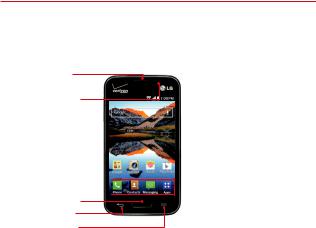
4The Basics
Phone overview
Front View
 Earpiece
Earpiece
 Proximity
Proximity
sensor

 Home screen
Home screen
 QuickTap bar
QuickTap bar 

 Home key
Home key
 Back key
Back key
 Menu key
Menu key
1.Earpiece Lets you hear callers and automated prompts.
2.Proximity sensor Senses proximity toward other objects (such as your head) so that tap commands are not accidentally activated during a call. It also employs an ambient sensor which measures the surrounding light and adjusts the LCD brightness to provide a vivid screen.
NOTES • Do not block the sensor or near the sensor to avoid problems with the touchscreen.
•When receiving and making calls, the proximity sensor automatically turns the backlight off and locks the touchscreen by sensing when the phone is near your ear. This extends battery life and prevents you from unintentionally activating the touchscreen during calls.
3.QuickTap bar Provides icons for quick, one-touch access to the apps you use most often.
NOTE You can change the icons in the QuickTap Bar to suit your needs. To reposition, add, or remove an icon, see page 16.
4.Home key Press to return to the Home screen (or your default Home screen panel from any of the Home screen extension panels). You can also press it to wake your phone from screen timeout. Press and hold it to display recently used apps with access to the Task Manager app.
NOTE The Home key LED will illuminate when you have pending notification(s).
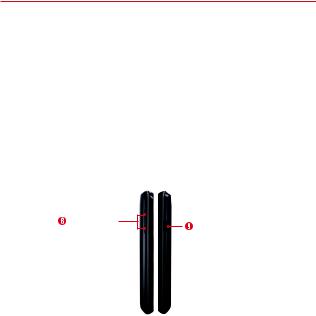
The Basics 5
5.Back key Tap to return to the previous screen. It also closes pop-up items such as menus, dialog boxes, and the on-screen keyboard.
6.Menu key Tap to open an Options menu with options that affect the current screen or app. This only applies when available, depending on the screen or app.
7.Home screen Displays all of the items needed to operate your phone including icons for app access, widgets, and the Status Bar (with status icons) allowing simple touch access to all of its functions and features.
WARNING! Placing a heavy object on the phone or sitting on it can damage the LCD and touchscreen functions. Covering the proximity sensor with a protective film could cause the sensor to malfunction.
Side Views
Volume keys
Power/Lock key
8.Volume keys Press to adjust the ringer, the media volumes, or the in-call volume during a call.
9.Power/Lock key Press to turn off the screen backlight and lock the screen, or turn the screen backlight back on. Press and hold to turn the phone on/off, restart it, activate/deactivate Airplane mode, and change the sound settings.
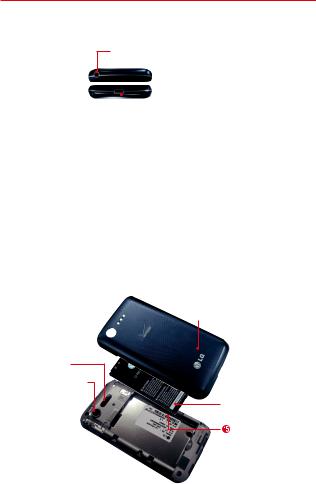
6The Basics
Top and Bottom View
 3.5mm Headset jack
3.5mm Headset jack

 Microphone
Microphone

 USB/Charging port
USB/Charging port
10.3.5mm Headset jack Allows you to plug in an optional headset for convenient, hands-free conversations. You can also plug in headphones to listen to music.
11.Microphone Transmits your voice to the other caller. It's also used for voice-activated functions and voice recorder functions.
NOTE Please be careful not to block the microphone with your hand during calls.
12.USB/Charging port Allows you to connect the phone and the USB Cable for use with the Charger Adapter, or other compatible accessories.
NOTE You may purchase a separate fast data cable from LG for higher data transfer speed with compatible devices (e.g. laptop).
Rear View

 Back cover
Back cover
 Speaker
Speaker
 Camera lens
Camera lens
 Battery
Battery
microSD Card slot
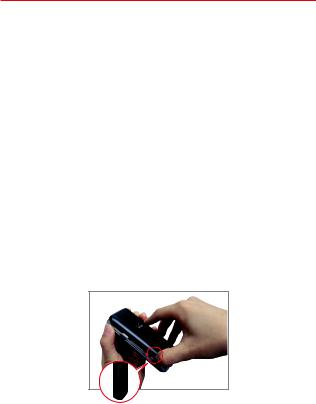
The Basics 7
13.Speaker Use to listen to the audio from the selected function (e.g., music, videos, sound clips, etc.).
14.Camera lens Use to take photos and record videos. Keep it clean for optimal performance.
15.MicroSD Card slot Use for additional storage space of items such as pictures, videos, music, etc.
16.Battery Fully charge the battery before initial use to optimize your battery life.
17.Back cover Protects the battery and internal antenna. Keep it from getting scratched or damaged.
Installing the battery
Before you can start using your new phone, you'll need to do a little set up such as installing and charging the battery.
1.To remove the back cover, hold the phone firmly in one hand. With your other hand, place your thumbnail in the cutout on the side of the phone as shown in the illustration below.
NOTE Make sure to turn the phone off before removing the battery.
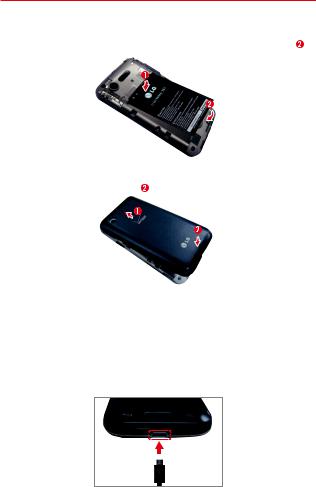
8The Basics
2. Insert the battery into the opening on the back on the phone, making sure the connectors align  and press down until it clicks into place .
and press down until it clicks into place .
3. Align the back cover over the battery compartment  and press down along the outer edge of phone .
and press down along the outer edge of phone .
Charging the phone
Your phone comes with a USB Cable and a Charger Adapter which connect together to charge your phone. Fully charge the battery before using your phone for the first time to improve your battery lifetime.
The USB/Charging port is at the bottom of the phone. Insert one end of the USB Cable into the port and plug the Charger Adapter into an electrical outlet.

The Basics 9
WARNING! To avoid damage to your phone's port and cable plug, orient the plug with the port before inserting it.
NOTE Do not open the back cover while your phone is charging.
NOTE Only use approved charging accessories to charge your LG phone. Improper handling of the USB/Charging Port, as well as the use of an incompatible charger, may cause damage to your phone and void the warranty.
Optimizing Battery Life
Extend your battery's life between charges by turning off features that you don't need to have running constantly in the background.
Extending your phone's battery life:
Reduce the screen brightness setting and set a shorter screen timeout.
Turn off radio communications (such as Wi-Fi, Bluetooth, GPS, etc.) that you're not actively using.
Turn off automatic syncing for Gmail, Calendar, Contacts, and other apps.
Monitor the battery use screen to identify if apps you've downloaded are consuming a large percentage of your battery power.
NOTE Allowing other devices to use your phone's hotspot connection will also drain your battery more quickly.
To check the battery power level:
From the Home screen, tap the Menu key > Settings > About phone > Battery.
> Settings > About phone > Battery.
The battery status (charging or discharging) and battery level (percentage charged) are displayed.
To monitor and control how battery power is being used:
From the Home screen, tap the Menu key > Settings > About phone > Battery > Battery use.
> Settings > About phone > Battery > Battery use.
A battery usage graph is displayed along with battery usage time, estimated time remaining, and last 3 hours usage. The screen also lists the apps or services using battery power, listed in order from the greatest to the least amount used.
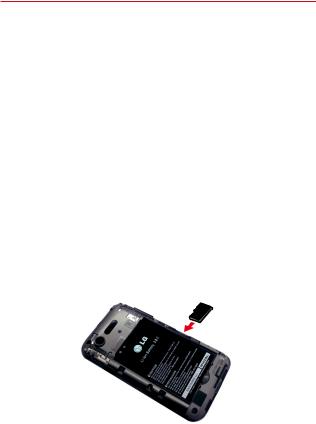
10The Basics
Battery saver mode
Battery saver mode changes certain settings to conserve battery power until you can recharge your phone. If you turn Battery saver mode on, it will automatically activate when the battery charge level drops to the level you set. If Battery saver mode is off, you will be prompted to turn on Battery saver mode when the battery reaches low levels.
1.From the Home screen, tap the Menu key > Settings > Battery >
> Settings > Battery >
Battery saver > Turn Battery saver on.
2.Select the option you want. Choose from Immediately, when the charge drops to 10%, 20%, 30%, and 50%.
3.Tap the switch  at the top of the screen to turn the feature on.
at the top of the screen to turn the feature on.
The memory card
WARNING! Unmount the microSD card before removing it from the phone to avoid damaging it. From the Home screen, tap the Menu key > Settings > Storage >
> Settings > Storage >
Unmount SD card.
1.Remove the back cover.
2.Insert the memory card into the slot (on the right side of the back of the phone) with the gold contact area facing downward.
Turning the Phone On and Off
To turn on your phone, press and hold the Power/Lock key (on the right side of the phone) for a couple of seconds until the screen lights up.
(on the right side of the phone) for a couple of seconds until the screen lights up.

The Basics 11
To turn off the phone, press and hold the Power/Lock key (on the right side of the phone), tap Power off in the menu that appears, then tap OK to confirm.
(on the right side of the phone), tap Power off in the menu that appears, then tap OK to confirm.
Locking and unlocking the screen
Using a Screen Lock
Set a screen lock to secure your phone and prevent unauthorized use.
From the Home screen, tap the Menu key > Settings > Lock screen
> Settings > Lock screen
> Select screen lock, then select your lock type (Swipe, Pattern, PIN, or Password).
NOTE If you choose Pattern, you'll be prompted to create a Backup PIN as a safety measure in case you forget your unlock pattern.
CAUTION Sign in to (or create) a Google Account before setting a screen lock (and remember the Backup PIN you created when creating your screen lock) to reduce the risk of needing to perform a Hard Reset which erases all of your data.
WARNING It's very important to remember the screen lock you set. After five incorrect attempts you'll be prompted to enter a phrase to verify that you're trying to unlock your phone. The phone will automatically reset itself and erase all of the phone's data after ten incorrect attempts.
When you can't recall your screen lock:
If you activated a Google Account on the phone, after 5 unsuccessful attempts you'll be prompted to enter a phrase to verify that you're attempting to unlock the phone. Then:
If you forgot your unlock pattern, you can tap Forgot pattern? (at the bottom of the screen). You can sign in to your Google Account or enter your Backup PIN to regain access to your phone.
If a Google Account wasn't activated on the phone before setting the lock
(or you also forgot your Backup PIN), the only way to regain access to the phone is to perform a Hard Reset which erases all of your user data.
CAUTION If you perform a Hard Reset, all user apps and user data will be deleted.

12The Basics
Performing a Hard Reset (Factory Reset)
If your phone does not restore to its original condition after an error or you forgot your screen lock, perform a Hard Reset (Factory Reset) to initialize it.
WARNING If you perform a Hard Reset, all user apps, user data, and DRM licenses will be deleted. Please remember to backup any important data before performing a Hard Reset.
1.Turn the phone off.
2.Press and hold the Power/Lock key (on the right side of the phone) and the Down Volume key
(on the right side of the phone) and the Down Volume key  (on the left side of the phone) at the same time.
(on the left side of the phone) at the same time.
3.When the Factory data reset screen appears, release both of the keys.
4.Use the Volume keys to highlight Factory data reset, then press the Power/Lock key
to highlight Factory data reset, then press the Power/Lock key  to confirm.
to confirm.
5.Use the Volume keys to highlight Yes, then press the Power/ Lock key
to highlight Yes, then press the Power/ Lock key  to confirm one more time.
to confirm one more time.
6.Your phone will perform a factory reset.
To unlock the phone
If you don’t use the phone for a while, the screen backlight will turn off to conserve battery power. To wake up the phone and unlock the screen:
1. Turn the screen on.
Press the Power/Lock key  on the right side of the phone.
on the right side of the phone.
2. The default Lock screen will appear.
To unlock the screen, swipe your finger across the screen in any direction.
To use a Swipe Lock screen shortcut, swipe the shortcut icon (at the bottom of the screen) in any direction. The screen will unlock and launch the app.
NOTE The default Lock screen simply locks the screen to prevent unintentional actions. For more security to guard against unauthorized use, you can set an unlock requirement (such as a pattern, PIN, or password) that will need to be entered to unlock it. Please refer to Using a Screen Lock on page 11 for more information.
TIP Swipe the left edge of the Lock screen to the right to add a widget to your Lock screen.

The Basics 13
Automatic timeout
If you'ren't actively using your phone, it will automatically timeout by turning off the backlight and locking the screen. This helps to prevent accidental taps and saves battery power.
Changing the screen timeout
From the Home screen, tap the Menu key > Settings > Display >
> Settings > Display >
Screen timeout.
To manually turn off and lock the screen:
Press the Power/Lock key  (on the right side of the phone).
(on the right side of the phone).
Apps do not stop running when you lock the screen. It's recommended that you exit or stop all apps before entering Lock mode to avoid unnecessary charges (e.g. phone calls, web access, and data communications).
To exit or stop apps:
To use the Recent apps screen, press and hold the Home key  , then swipe the app to the left or right off of the screen.
, then swipe the app to the left or right off of the screen.
To use the Battery use screen, tap the Menu key  > Settings > About phone > Battery > Battery use. Scroll to the Running apps list, then tap Stop next to each app to stop it from running.
> Settings > About phone > Battery > Battery use. Scroll to the Running apps list, then tap Stop next to each app to stop it from running.
Camera shortcuts
When the screen backlight is off, press and hold either of the Volume keys  (on the left side of the phone) to automatically open the Camera app.
(on the left side of the phone) to automatically open the Camera app.
From the Swipe Lock screen, swipe the Camera icon in any direction.
Swipe Lock screen shortcuts
There are four shortcut icons displayed at the bottom of the Swipe Lock screen. Swipe across any of the icons to open and use that app without unlocking the screen first.

14The Basics
When your phone is set to the Swipe Lock screen, you can change its shortcuts. From the Home screen, tap the Menu key  > Lock screen settings > Shortcuts. Tap the icon you want to change, tap the application you want, then tap Save.
> Lock screen settings > Shortcuts. Tap the icon you want to change, tap the application you want, then tap Save.
Global access shortcuts
There are two Global access shortcuts that you can access from any screen: Google Now and QuickMemo. To access these shortcuts, drag your finger upward from the main touch key area (Back, Home, Menu), move your finger over the icon you want to use, then lift your finger.
Phone sounds off
You can quickly silence your phone.
From the Home screen, press and hold the Power/Lock key  (on the right side of the phone), then tap the Silent mode icon
(on the right side of the phone), then tap the Silent mode icon  .
.
OR
Press the down Volume key  (on the left side of the phone) until vibration is set, then press it again to turn off all sounds.
(on the left side of the phone) until vibration is set, then press it again to turn off all sounds.
OR
Swipe the Status Bar downward to open the Notifications panel, then tap the Sound icon until the Silent icon  is displayed.
is displayed.
Data communications off
Airplane mode turns off all data communications.
From the Home screen, press and hold the Power/Lock key  (on the right side of the phone), then tap Turn on Airplane mode.
(on the right side of the phone), then tap Turn on Airplane mode.
OR
Swipe the Status Bar downward to open the Notifications panel, then tap the Airplane mode icon  (blue is on and gray is off).
(blue is on and gray is off).
To wake up your phone
Press the Power/Lock key  (on the right side of the phone).
(on the right side of the phone).

The Basics 15
OR
Press the Home key  . The Lock screen will appear. Swipe the Lock screen in any direction to unlock the screen. The last screen you viewed will open.
. The Lock screen will appear. Swipe the Lock screen in any direction to unlock the screen. The last screen you viewed will open.
Touchscreen tips
Here are some tips on how to navigate on your phone.
Touch or tap – A single finger tap selects items, links, shortcuts, and letters on the on-screen keyboard.
NOTES • To select an item, tap the center of the icon.
•Don't press too hard on the touchscreen. It's sensitive enough to pick up a light, yet firm tap.
•Use the tip of your finger to tap the option you want. Be careful not to tap any other keys.
Touch and hold – Touch and hold an item on the screen by touching it and not lifting your finger until an action occurs. For example, to open a contact's available options, touch and hold the contact in the Contacts list until the Context menu opens.
Drag – Touch and hold an item for a moment and then, without lifting your finger, move your finger on the screen until you reach the target position.
For example, you can drag items on the Home screen to reposition them.
Swipe, slide, or flick – Move your finger quickly across the surface of the screen, without pausing when you first touch it (so you don't drag an item instead). For example, you can browse through the different Home screens by swiping to the left or right, slide the screen up or down to scroll through a list, or remove an application from the Recent Apps screen by flicking its graphic off the screen.
Double-tap – Tap the screen twice quickly to zoom, highlight text, or turn the screen off. For example, quickly double-tap a section of a webpage to adjust that section to fit the width of the screen and zoom in and out when viewing a picture and when using Maps. Double-tap a word to highlight it.

16The Basics
Pinch-to-zoom – Use your index finger and thumb in a pinching motion (to zoom out) or spreading motion (to zoom in) when using Chrome, a map, photos, the Contacts list, the Favorites list, the Groups list, a music list, and Polaris Viewer 5 documents. Spread apart to make screen information larger (easier to see and read), or pinch together to view more area and information. The pinch gesture also changes the Home screen. Pinch in on the Home screen to change to mini canvas view, then spread apart to return to the normal Home screen view. Spread apart on the normal Home screen to hide all of your Home screen items, then pinch in to redisplay them.
Rotate the screen – From many apps and menus, the orientation of the screen adjusts to the device's physical orientation. You can deactivate this function in the Display settings menu.
Home screen
The Home screen is the starting point to access all of your phone's features using simple motions on the touchscreen. It's comprised of multiple panels you can customize with shortcuts.
Simply swipe your finger to the left or right to view the Home screen panels. Tap any icon to open, access, and use it.
The QuickTap Bar is at the bottom of all of the Home screen panels. The icons displayed in this bar provide easy and one-tap access to the functions you use the most.
Tap Phone to bring up the dialpad to make a call. The Dial tab is displayed, but this icon also provides access to other tabs (Recent,
Contacts, Favorites, and Groups) at the top of the screen to make calls from information stored in your phone.
Tap the Contacts icon to open your contacts. The Contacts tab is displayed, but this icon also provides access to other tabs (Dial,
Recent, Favorites, and Groups) at the top of the screen to help you find information stored in your phone.

The Basics 17
Tap the Messaging icon to access the Messaging app, where you can view and create text and multimedia messages.
Tap Apps to view all of your installed apps. Simply tap any icon to open and use it.
Changing the QuickTap Bar:
To add an icon, drag it into the QuickTap Bar and release it.
To remove an icon, drag it out of the QuickTap Bar to the Remove icon (that appears at the top of the screen) and release it.
To change the order of the icons, drag an icon to the new position.
Customizing the Home screen
For more convenience using your phone, add your favorite apps, widgets, and downloads to the Home screen for quick access. You can also change the wallpaper to reflect your personal style.
TIP From the Home screen, tap the Menu key  , tap Home screen settings, then checkmark Portrait view only to keep the Home screen from rotating to landscape view. This is a separate setting from the Auto-rotate screen setting that applies to the rest of the screens.
, tap Home screen settings, then checkmark Portrait view only to keep the Home screen from rotating to landscape view. This is a separate setting from the Auto-rotate screen setting that applies to the rest of the screens.
To add items on your Home screen:
1.Touch and hold the empty part of any Home screen panel.
2.Tap the Apps or Widgets tab at the bottom of the screen.
3.Tap the app icon you want to automatically place it on the Home screen panel.
4.To exit, tap the Back key  or tap the Home screen panel.
or tap the Home screen panel.
NOTE You can also drag the app icon you want to any of the Home screen panels.
To remove an item from the Home screen:
Touch and hold the icon you want to remove, drag it to the Remove icon (that appears at the top of the screen), then release it.
NOTE To view the details of an app, drag the icon to the App info icon (that appears at the top of the screen).

18The Basics
Moving items and creating folders
Drag an icon or widget to move it to any of the other Home screen panels.
Drag an icon onto another icon to create a folder with both of the icons in it. Drag another icon onto the folder to add it to the folder to help keep you organized.
Customizing app icons
You can create your own custom app icons using the images in your Gallery. Your customized icons are only applied to the Home screen. The Apps screen isn't affected by your changes.
1.Touch and hold the icon you want to customize, then release the icon.
An editing icon  appears in its upper-right corner.
appears in its upper-right corner.
2.Tap the icon.
3.The following options are available.
Tap the image you want from the Theme icon tab, and change the size (if desired), then tap OK.
OR
Tap the Photo icon tab, then tap Add new and select a size. Tap the album. Tap the image. Tap how to crop the image (Crop photo or Crop picture), then select Just once or Always. Crop the image, then tap
OK or Save.
TIP Your custom photo icons are saved so you can easily select them for any of your icon images.
Changing an icon into a widget
Some app icons can be changed into a convenient widget to use on your
Home screen.
1. Touch, hold, and release a Home screen icon.
A blue frame appears around the icon if it can be resized and changed into a widget (if it can't, only the Edit icon is displayed).
2.Drag the corners of the frame to make it larger and change it into a widget.

The Basics 19
Touch, hold, and release the widget again to change the size of the widget, if necessary.
You can also change it back into a normal icon by dragging the corners of the resizing frame back in.
Home screen Options menu
From the Home screen, tap the Menu key to access the following options:
to access the following options:
Add apps & widgets – Allows you to customize your Home screen with apps, widgets, and wallpaper.
Theme – Sets the style of your Home screen. Choose from LG, Biz, and Marshmallow.
Home screen settings – Sets the settings specific to the Home screen. (These are the same settings as in the full Settings menu in the Home screen sub-menu.)
Lock screen settings – Allows you to change your Lock screen settings. (These are the same settings as in the full Settings menu in the Lock screen sub-menu.)
Settings – Opens the full Settings menu.
Mini panel view
Pinch in on the Home screen to change to mini panel view. Mini panel view allows you to manage your Home screen panels. You can add, delete, rearrange, and set your default panel.

20 The Basics
Tap the Add icon  to add a new panel.
to add a new panel.
Drag a panel to the Remove icon  that appears at the top of the screen to delete it.
that appears at the top of the screen to delete it.
Drag a panel to a new position to rearrange your panels.
Tap Set default Home screen (at the bottom of the screen) to change the panel that is displayed when you press the Home key  .
.
NOTE Tap any of the panels in mini panel view to go directly to that panel.
Hide view
Place two fingers on the Home screen and spread them apart to hide all of the items on your Home screen. In hide view, only your wallpaper and the
Status Bar are seen.
To return to normal view, place two fingers on the Home screen and pinch them in. You can also press the Home key or the Back key
or the Back key  .
.
Dual view
Dual view allows you to customize your Home screen panels by displaying your Home screen panels (on top) and the Apps screen (on the bottom) at the same time.
Touch and hold an empty spot on a Home screen panel.
OR
From the Home screen, tap the Menu key  , then tap Add apps & widgets.
, then tap Add apps & widgets.

The Basics 21
In dual view, the current Home screen is displayed above selection choices. Three tabs are displayed along the bottom. Tap App, Widgets, or Wallpaper.
The Apps screen
The Apps screen allows you to access all of the apps installed on your phone.
From the Home screen, tap Apps  .
.
Apps screen Options menu
While viewing the Apps screen, tap the Menu key  to access the following options:
to access the following options:
View apps by – Allows you to change how your apps are displayed. Choose from Alphabetical order, Downloaded date, and User customized.
Apps wallpaper – Sets the wallpaper background displayed for your Apps screen.
Hide/Show apps – Allows you to select which apps to hide (or show again) on the Apps screen.
Opening, switching, and stopping apps
Multi-tasking is easy with Android because you can keep multiple apps running at the same time. Use and switch between several open apps.
Android manages each running app to ensure that idle apps don't consume resources unnecessarily, but you can also manually stop apps from running.
Opening an app
On the Home screen: Tap the app icon you want to open.
OR
From the Home screen: Tap Apps  > the Apps tab (if necessary), then tap the icon you want to open.
> the Apps tab (if necessary), then tap the icon you want to open.

22 The Basics
Opening apps and switching apps
1.Open an app by tapping its icon.
2.Press the Home key  .
.
3.Open another app.
Tap another app icon (on the Home screen or in the QuickTap Bar).
OR
Tap Apps  , tap the Apps tab (if necessary), then tap the app icon you want.
, tap the Apps tab (if necessary), then tap the app icon you want.
4.Press and hold the Home key to open the Recent apps screen. Tap an open app to switch to it.
to open the Recent apps screen. Tap an open app to switch to it.
Stopping apps from running
1.From the Home screen, tap the Menu key  > Settings > Application manager.
> Settings > Application manager.
2.Scroll horizontally to display the Running app list tab, tap the desired app, then tap Stop (or Force stop) to stop it.
Notifications
Notifications alert you to the arrival of new messages, calendar events, and alarms, as well as to ongoing events, such as video and music downloads.
The Status Bar displays your phone's current status and pending notifications.
When a notification arrives, its icon appears at the top of the screen.
Pending notification icons appear on the left and system icons (that indicate things like Wi-Fi or battery strength) are displayed on the right.
Pending notifications |
System notifications |
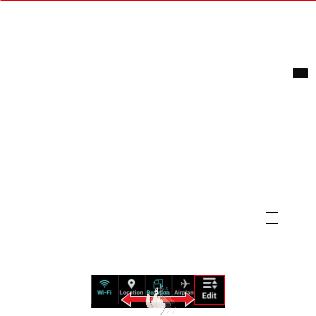
The Basics 23
Accessing the Notifications Panel
Swipe the Status Bar downward to open the Notifications Panel. Tap a notification to open its associated app. To close the Notifications Panel, swipe the bar at the bottom of the screen upward or tap the Back key  .
.
Quick Settings
The Quick Settings allow you to easily toggle function settings like Wi-Fi, manage display brightness, and more. To access the Quick Settings, open the Notifications Panel. The Quick Settings bar is located at the top of the Notifications Panel.
To rearrange Quick Setting items on the Notification Panel
Swipe the Quick Settings bar to the left, then tap the Edit icon  to customize the Quick Settings bar. Checkmark the desired icons to display them (or remove the checkmark to hide). Drag an icon's handle
to customize the Quick Settings bar. Checkmark the desired icons to display them (or remove the checkmark to hide). Drag an icon's handle 
 move it to another position on the bar.
move it to another position on the bar.
NOTE Changing the checkmark(s) also reorganizes the icons in the Quick Settings bar.
TIP Touch and hold an icon on the Quick Settings bar to directly access its settings menu.
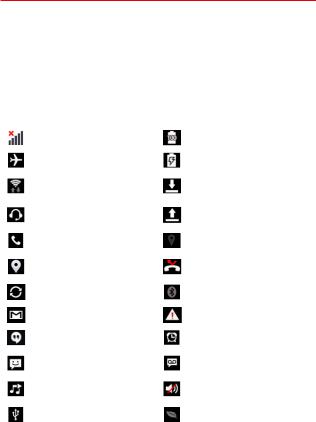
24The Basics
Notification icons on the Status Bar
Notification icons appear on the Status Bar at the top of the screen to report missed calls, new messages, calendar events, device status, and more.
The following table lists some of the most common icons.
Icon |
Description |
Icon |
Description |
||
|
|
|
|
|
|
|
|
|
No signal |
|
Battery is fully charged |
|
|
|
|
|
|
|
|
|
Airplane mode is on |
|
Battery is charging |
|
|
|
|
|
|
|
|
|
Connected to a Wi-Fi |
|
Downloading data |
|
|
|
|
||
|
|
|
network |
|
|
|
|
|
|
|
|
|
|
|
Wired headset (with |
|
Uploading data |
|
|
|
microphone) is connected |
|
|
|
|
|
|
|
|
|
|
|
Call is in progress |
|
Acquiring GPS |
|
|
|
|
|
|
|
|
|
Receiving location data |
|
Missed call |
|
|
|
|
||
|
|
|
from GPS |
|
|
|
|
|
|
|
|
|
|
|
Data is syncing |
|
Bluetooth is on |
|
|
|
|
|
|
|
|
|
New Gmail message |
|
System warning |
|
|
|
|
|
|
|
|
|
New Hangouts message |
|
Alarm is set |
|
|
|
|
|
|
|
|
|
New text or multimedia |
|
New voicemail |
|
|
|
message |
|
|
|
|
|
|
|
|
|
|
|
Song is playing |
|
Ringer is silenced |
|
|
|
|
|
|
|
|
|
Phone is connected to PC |
|
Battery saver is on |
|
|
|
via USB Cable |
|
|
|
|
|
|
|
|
|
|
|
|
|
|
NOTE The location of the icons in the Status Bar may differ depending on the functions, features, and apps being used.

The Basics 25
On-screen keyboard
You can enter text using the on-screen keyboard. The on-screen keyboard appears automatically on the screen when you need to enter text. To manually display the keyboard, simply tap a text field where you want to enter text.
Using the keyboard and entering text
Tap once to capitalize the next letter you type. Double-tap for all caps.
Tap to switch to toggle between keyboards (normal letters and the numbers/symbols keyboard that also includes graphics, such as faces and images).
Tap to enter text using your voice. This is only available when you activate Google voice typing in the keyboard settings. Touch and hold to access the LG Keyboard settings.
Tap to access the LG Keyboard settings. Touch and hold to access voice input mode.
Tap to enter a space.
Tap to create a new line in the text field.
Tap to delete the previous character.
Entering special characters
The LG Keyboard allows you to enter special characters (e.g. “á”) when entering text.
For example, to enter “á”, touch and hold the “a” key. When the pop-up with its additional characters is displayed, slide your finger over the "á", then lift your finger to enter it.
NOTE A symbol at the top right corner of a key indicates that additional characters are available for that key.

26 The Basics
Cut, copy, and paste text
You can highlight text to cut or copy it, then paste it into another text field.
To highlight a word, double-tap it.
To highlight a range of text, double-tap the word, then drag the blue highlight markers to encompass the text you want.
To cut or copy highlighted text, tap Cut or Copy in the action box that appears.
To paste text, tap the location where you want to place the text, then tap the marker  . Tap Paste in the action box that appears.
. Tap Paste in the action box that appears.

Google Account Setup 27
The first time you open a Google app on your phone, you'll be required to sign in with your existing Google Account. If you don't have a Google
Account, you'll be prompted to create one.
Creating your Google Account
1.From the Home screen, tap the Menu key  > Settings.
> Settings.
2.Tap Add account (under the Accounts section) > Google > New to start the Gmail set up wizard.
3.Tap a text field to open the keyboard and enter your name and username for your Google Account. When entering text, you can move to the next text field by tapping Next on the keyboard.
4.When you have finished entering your name and username, tap the Next icon  . Your phone then communicates with Google servers and checks for username availability.
. Your phone then communicates with Google servers and checks for username availability.
5.Enter and re-enter your password. Then follow the instructions and enter the required and optional information about the account. Wait while the server creates your account.
Signing in to your Google Account
1.From the Home screen, tap the Menu key  > Settings > Add account (under the Accounts section) > Google > Existing.
> Settings > Add account (under the Accounts section) > Google > Existing.
2.Enter your email address and password, then tap the Next icon  .
.
3.Once you've set up your Google Account on your phone, it'll automatically be synchronized with your Google Account on the web (depending on your synchronization settings).
After signing in, you can use Gmail and Play Store; back up your settings to Google servers; and take advantage of other Google services on your phone.

28 Connecting to Networks and Devices
Wi-Fi
By connecting with Wi-Fi, you can use high-speed Internet access within the coverage of the wireless access point (AP). Enjoy wireless Internet using Wi-Fi, without extra charges.
Connecting to Wi-Fi networks
To use Wi-Fi on your phone, you need to access a wireless access point or 'hotspot'. Some access points are open and you can simply connect to them. Others are hidden or use security features, you must configure your phone to be able to connect to them.
Turn off Wi-Fi when you're not using it to extend the life of your battery.
NOTE If you're out of the Wi-Fi zone or have set Wi-Fi to off, additional charges may be applied by your mobile service provider for mobile data use.
Turning Wi-Fi on and connecting to a Wi-Fi network
1.From the Home screen, tap the Menu key  > Settings > Wi-Fi.
> Settings > Wi-Fi.
2.Tap the Wi-Fi switch  to turn it on and start scanning for available Wi-Fi networks.
to turn it on and start scanning for available Wi-Fi networks.
Secured networks are indicated by a lock icon.
3. Tap a network to connect to it.
If the network is secured, you're prompted to enter a password or other credentials. (Ask your network administrator for details).
NOTE The Status Bar displays a Wi-Fi icon to indicate its status.
Adding a Wi-Fi network
1.Turn on Wi-Fi, then tap Wi-Fi to access its settings.
2.Tap the Menu key  > Add network.
> Add network.
3.Enter the Network SSID (network name).
Tap Security and select the network security type, if the network is secured.
Enter the required passwords and security credentials.
